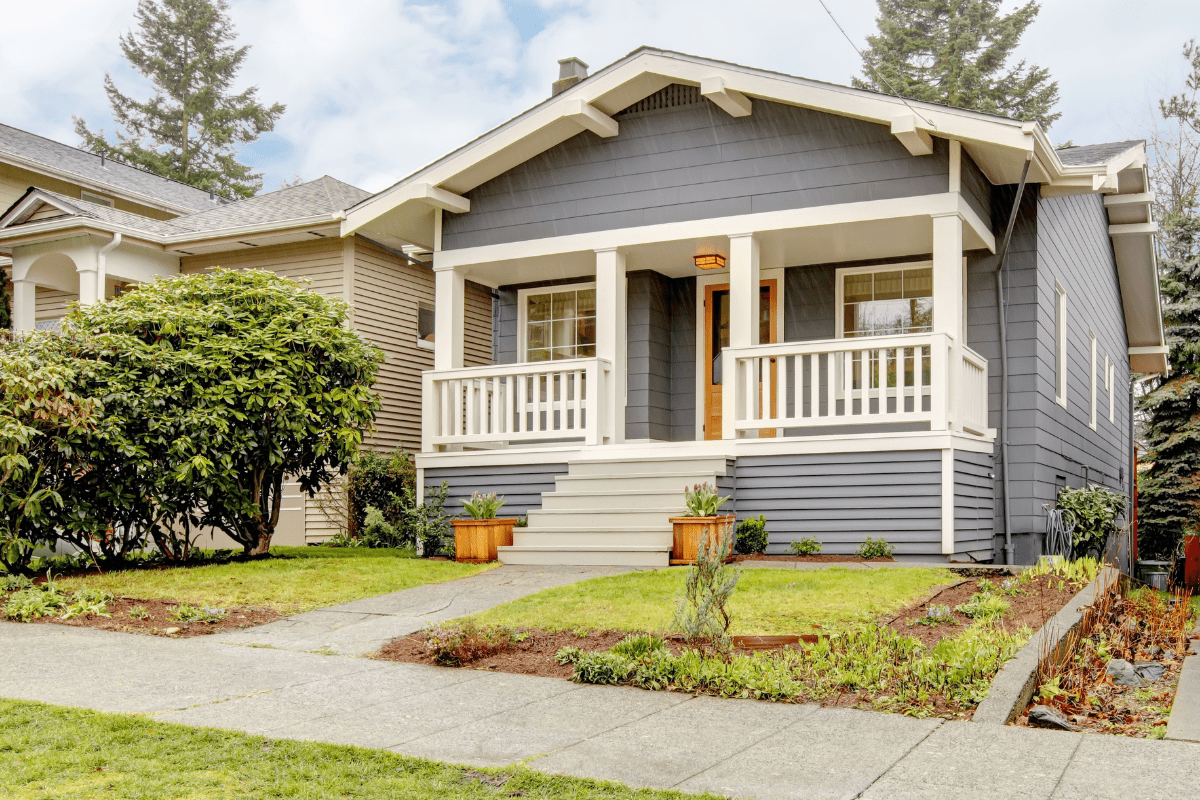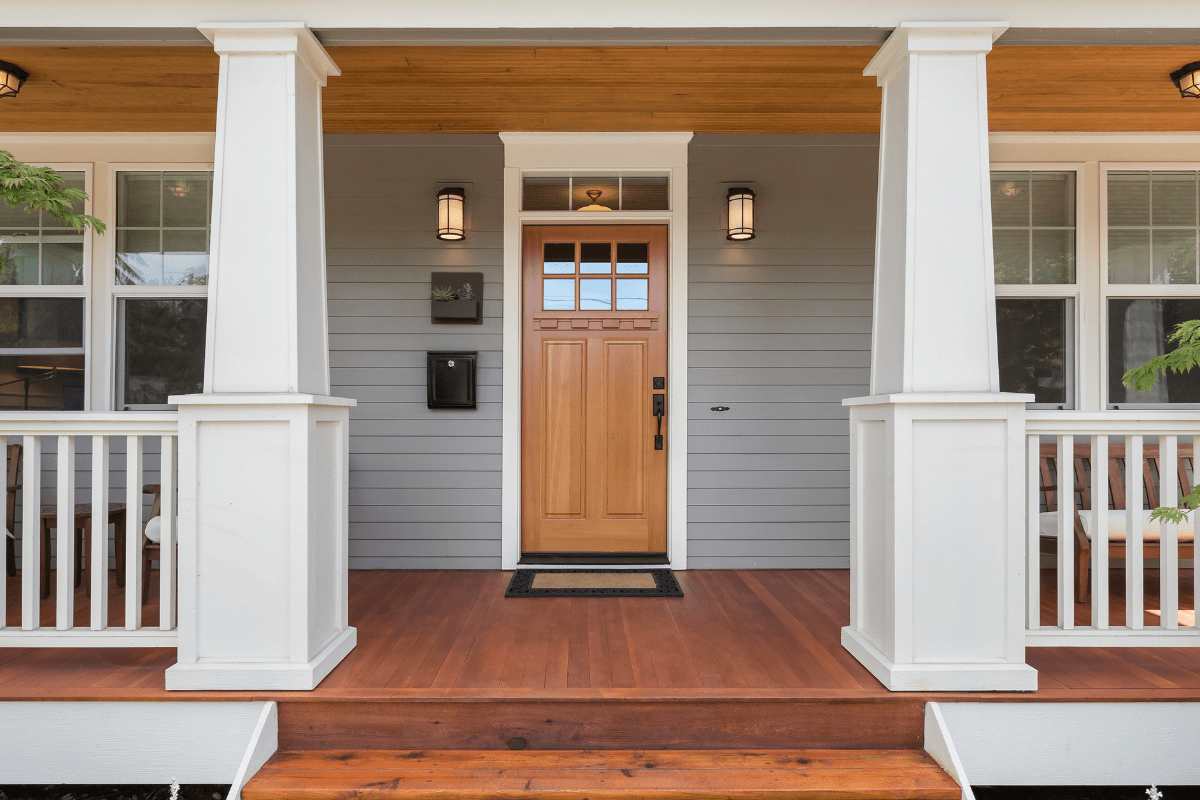Ever wondered why your neighbor's house looks like it belongs in medieval England while yours screams "1970s sitcom set"? Washington's neighborhoods are like architectural time capsules, each street telling stories through shingles, siding, and sometimes questionable color choices from decades past.
From Seattle's craftsman bungalows to Spokane's Tudor revivals, understanding these architectural styles transforms your daily dog walk into a journey through history. Plus, knowing what style your house is can finally help you explain to contractors why your windows are shaped like that… and why they'll cost a fortune to replace.
The Craftsman style: Washington's architectural sweetheart
Walk through any established Washington neighborhood and you'll spot them immediately: those cozy houses with the big front porches and exposed roof beams that make you want to grab a cup of coffee and contemplate life. The Craftsman style dominated Washington's residential scene from 1905 to 1930, becoming as quintessentially Northwest as complaining about Californians moving here.
Spotting a Craftsman house in the wild
These homes practically shout "I'm sturdy and unpretentious!" with their distinctive architectural features. Look for:
- Low-pitched roofs with deep overhangs
- Exposed rafter tails (those beam ends you can see)
- Tapered porch columns on stone piers
- Built-in bookcases and window seats
- Natural wood everywhere (and we mean everywhere)
The style reflected a philosophical rebellion against Victorian excess, embracing honest materials and simple forms. Seattle architect Ellsworth Storey took this concept and ran with it, developing what became known as the Northwest Regional approach. His designs in Denny-Blaine and Mount Baker incorporated river stones and naturally weathered cedar shingles, creating homes that looked like they grew from the landscape itself.
Spokane surprises visitors with one of the nation's best concentrations of Craftsman architecture, particularly around Manito Park. Apparently, Spokane's historic neighborhoods decided to go all-in on the Craftsman craze, resulting in entire streets where every house features those characteristic front porches perfect for passive-aggressively monitoring your neighbors' yard maintenance habits.
Ranch houses: When Washington went horizontal
After World War II, Washingtonians apparently decided stairs were overrated. The Ranch style swept through suburban developments from 1945 through the 1970s, with over 3,500 examples currently for sale across the state. These single-story sprawlers changed how families lived, bringing a casual California vibe to the Pacific Northwest.
Ranch houses are the golden retrievers of architecture… friendly, unpretentious, and taking up way more space than necessary. Their identifying features include:
- Single story (obviously)
- Low-pitched roofs
- Large picture windows
- Sliding glass doors to the backyard
- Open floor plans
- Attached garages (revolutionary at the time)
Washington builders cleverly adapted the style for our region's sloped lots, creating split-level variations that made your friend's basement rec room only partially underground. These adaptations proved so popular that nearly every suburban neighborhood built between 1950 and 1975 features at least a few examples. Eastern Washington's flatter terrain embraced the original Ranch concept even more enthusiastically, with homes stretching across the agricultural landscape like they're trying to claim as much horizon as possible.
Colonial Revival: New England comes to the Northwest
Between 1880 and 1960, Washingtonians experienced serious architectural FOMO about the East Coast. Colonial Revival homes brought a dose of American heritage to the Pacific Northwest, complete with symmetrical facades and shutters that, let's be honest, rarely actually shut.
The appeal of symmetry and tradition
During the style's peak from 1910 to 1930, approximately 40% of American homes adopted Colonial Revival features. These houses exude a certain "trust me, I'm respectable" vibe with their perfectly balanced designs and classical details.
Key features that scream "I appreciate American history":
- Centered front doors (symmetry is key)
- Multi-pane double-hung windows
- Decorative shutters
- Classical columns or pilasters
- Dormer windows
The Williamsburg Revival subtype became particularly popular in Washington from 1930 to 1950. These homes feature distinctive second-story dormers marching across steep side-gable roofs like well-behaved architectural soldiers. After 1920, brick veneer construction made this traditionally expensive style more accessible to middle-class buyers, spreading the Colonial Revival gospel throughout Seattle and Tacoma's developing neighborhoods.
Victorian houses: When more was definitely more
If Craftsman homes are the comfortable fleece vest of architecture, Victorian houses are the sequined ball gown with optional bustle attachment. Built during Washington's late 1800s building boom, these homes announced their owners' success through sheer architectural audacity.
Maximum drama, minimum restraint
Victorian homes don't do subtle. Their elaborate ornamentation includes everything from decorative shingles to wooden "gingerbread" trim that would make Hansel and Gretel jealous. Identifying features include:
- Asymmetrical facades (symmetry is boring)
- Complex rooflines with turrets
- Bay windows galore
- Wraparound porches with spindlework
- Mixed textures and patterns
Port Townsend preserved its Victorian heritage beautifully, creating a town that looks like a movie set for a period drama. Tacoma's North Slope Historic District takes it even further, maintaining over 950 Victorian properties in what amounts to an architectural time warp.
Seattle's 1889 Great Fire inadvertently helped preserve residential Victorian neighborhoods by pushing commercial development elsewhere. The Ward House from 1882 stands as one of Seattle's oldest residences, surviving everything from fires to tech booms while maintaining its Victorian dignity.
Tudor Revival: Bringing medieval England to the Pacific Northwest
The 1920s and 1930s saw Washingtonians embrace their inner Anglophile through Tudor Revival architecture. These homes transport you to the English countryside, minus the actual English weather (though Seattle tries its best).
Storybook charm meets Pacific Northwest reality
Tudor Revival became Washington's second-most popular style after Colonial Revival during its heyday. These homes feature everything you'd expect from a house that's cosplaying as a medieval manor:
- Steeply pitched roofs (great for rain)
- Decorative half-timbering
- Tall, narrow windows with diamond panes
- Massive chimneys with decorative pots
- Heavy wooden doors in arched openings
Architect Kirtland Cutter's 1901 Stimson-Green Mansion in Seattle shows what happens when Tudor Revival meets unlimited budget. The mansion mixes Tudor elements with Gothic, Moorish, and Romanesque influences in what can only be described as architectural fusion cuisine.
More modest Tudor Revivals populate neighborhoods like Laurelhurst and Magnolia, where brick or stone first floors combine with stucco and timber-framed upper stories. The Tudor Composite substyle, popular from 1925 to 1940, softened the medieval severity by incorporating Colonial details, creating homes that looked like they couldn't decide which century they belonged to.
Contemporary Northwest: When architecture goes native
The Contemporary Northwest style represents Washington's unique contribution to American residential architecture. Emerging in 1935 and experiencing a major revival since 2000, these homes look like they grew from the forest floor, which was basically the point.
Embracing the landscape (literally)
Contemporary Northwest homes don't fight their surroundings… they join them. CTA Design Builders describes these houses as celebrating the relationship between structure and site. Key features include:
- Extensive unpainted wood siding
- Dramatically overhanging eaves (4+ feet)
- Walls of windows
- Post-and-beam construction
- Natural weathering to silver-gray
The style strips away unnecessary ornamentation, letting the beauty of regional materials shine. Western red cedar siding weathers naturally to a distinguished silver-gray, like a architectural George Clooney. Modern practitioners like Tom Kundig continue evolving the tradition, creating homes that feel both timeless and thoroughly contemporary.
These houses make extensive use of glass to blur the boundaries between inside and outside, which is fantastic until you realize the deer can see your TV and have opinions about your Netflix choices.
Mid-Century Modern: The future was yesterday
Post-World War II optimism brought Mid-Century Modern architecture to Washington between 1945 and 1965. These homes promised a bright future full of open floor plans and walls of glass, delivering on everything except the flying cars.
When less became more
Washington embraced modernism with enthusiasm, adapting international style principles to regional conditions. The state has documented over 350 mid-century properties through its wonderfully named "Nifty from the Last 50" preservation initiative.
Mid-Century Modern homes are immediately recognizable by their:
- Flat or barely-there roofs
- Floor-to-ceiling windows
- Post-and-beam construction
- Open floor plans
- Connection to outdoor spaces
Architects Paul Hayden Kirk and Paul Thiry led the Northwest's interpretation, designing homes with large south-facing windows to capture limited winter sunlight and deep overhangs for rain protection. Their work concentrated in Seattle's Capitol Hill, Bellevue, and throughout King County created neighborhoods that still look like the set of Mad Men, minus the problematic office behavior.
Regional variations: Geography is destiny
Washington's diverse geography creates distinct architectural personalities across the state. It turns out that building in a rainforest is different from building in a desert, who knew?
West vs. East: A tale of two climates
Western Washington's 100+ inches of annual rainfall shaped every architectural decision. Steep roofs, deep overhangs, and elevated foundations became survival strategies rather than design choices. Cedar siding wasn't just aesthetic… it was moisture management.
Eastern Washington's drier climate allowed more flexibility. Ranch houses spread across the agricultural landscape without worrying about moss taking over. Flatter roofs work fine when you're not constantly fighting the rain.
Notable architectural communities developed distinct flavors:
- Seattle's Ballard: Scandinavian-influenced Craftsman
- Tacoma's Stadium District: Grand historic mansions
- Spokane's South Hill: Tudor Revival concentration
- San Juan Islands: Water-view maximizing designs
- Coastal communities: Weather-resistant cedar fortresses
Materials matter: Building with what you've got
Washington's abundant forests provided the raw materials for its architectural identity. Western red cedar's natural rot resistance made it the superhero of siding materials, while Douglas fir's strength supported the post-and-beam construction that defines so many regional styles.
Shaking things up: Seismic considerations
Here's a fun fact that might keep you up at night: many of Washington's charming historic homes predate our understanding of the Cascadia Subduction Zone. Modern building codes require earthquake resistance, but thousands of older homes remain vulnerable.
Current retrofitting efforts try to balance preservation with safety, often requiring creative engineering solutions. It's like trying to teach your Victorian grandmother how to breakdance… technically possible, but requiring significant structural support.
The future is green (and still loves wood)
Contemporary Washington architects continue the tradition of environmentally responsive design while adding 21st-century sustainability features. The Living Building Challenge, pioneered by Northwest architects, requires buildings to produce as much energy as they consume.
Modern green features becoming standard:
- Rainwater collection systems
- Integrated solar panels
- Super-insulated walls
- FSC-certified lumber
- Passive house principles
Companies like Dwell Development and GreenPod Development are proving that sustainable can also be stylish, creating homes that would make both your hippie uncle and design-conscious friend happy.
Preserving the past while building the future
Washington's preservation community works overtime to maintain architectural heritage while addressing contemporary needs. Organizations like Historic Seattle and the Washington Trust for Historic Preservation fight the good fight, trying to save buildings from the wrecking ball of progress.
The challenge? Balancing density needs with historic character. Seattle's eight historic districts struggle with this daily, as original single-family homes face pressure to become multi-unit buildings. It's like trying to preserve your grandmother's china while hosting a frat party… theoretically possible but requiring careful planning.
Success stories provide hope. Pike Place Market's 1960s preservation campaign proved that saving old buildings could revitalize entire districts. Even Seattle's houseboat community, once dismissed as "rickety shanties," achieved protection and now ranks among the city's most desirable addresses. Apparently, one generation's eyesore is another generation's architectural heritage.
Your neighborhood architecture decoder
Understanding Washington's architectural styles transforms every walk into a history lesson. Whether you're house-hunting, trying to date your home for renovation purposes, or just satisfying curiosity about why your neighbor's house looks like a medieval castle, recognizing these styles connects you to the generations who shaped Washington's built environment.
Each style tells a story… Craftsman homes speak of early 20th-century idealism, Ranch houses recall post-war optimism, and Contemporary Northwest designs celebrate our unique landscape. Even those Tudor Revivals that look slightly out of place remind us that Washingtonians have always been willing to embrace the unexpected.
So next time you're wandering your neighborhood, take a closer look at the houses around you. That boring Ranch might be a perfect example of mid-century suburban planning. The weird Victorian on the corner could be one of the oldest buildings in your area. And that Contemporary Northwest house that looks like an expensive wooden box? It's actually an expensive wooden box that perfectly captures our regional identity. Architecture is funny that way.





